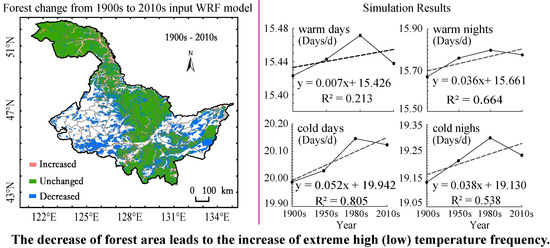The Effects of Forest Area Changes on Extreme Temperature Indexes between the 1900s and 2010s in Heilongjiang Province, China
Abstract
:1. Introduction
2. Study Area
3. Data
3.1. Heilongjiang Province Forest Coverage
3.2. Heilongjiang Province Land Cover Data during the 1900s
4. Methods
4.1. Experimental Design
4.2. Extreme Climatic Indicators
4.3. Trend Analysis
5. Results and Analysis
5.1. Spatiotemporal Analysis of Changes in Forest Cover over the Last 100 Years
5.2. The Effect of Forested Area Changes on Trends in Extreme Temperature over the Last 100 Years
5.2.1. Extreme High Temperature Indexes
5.2.2. Extreme Low Temperature Indexes
5.2.3. Daily Extreme Temperature Indexes
5.3. Forest Area Changes and Spatial Changes in Extreme Temperature Indexes over the Last 100 Years
6. Discussion
7. Conclusions
Acknowledgments
Author Contributions
Conflicts of Interest
References
- Intergovernmental Panel on Climate Change (IPCC). Climate Change 2013: The Physical Science Basis: Contribution of Working Group I to the Fifth Assessment Report of the Intergovernmental Panel on Climate Change; Cambridge University Press: Cambridge, UK; New York, NY, USA, 2013. [Google Scholar]
- Pielke, R.A. Land use and climate change. Science 2005, 310, 1625–1626. [Google Scholar] [CrossRef]
- Hua, W.J.; Chen, H.S.; Li, X. Effects of future land use change on the regional climate in China. Sci. China Earth Sci. 2015, 58, 1840–1848. [Google Scholar] [CrossRef]
- Li, J.H.; Chen, H.S.; Hua, W.J. Sensitivity experiments on impacts of large-scale land use change on surface energy balance, hydrological cycle and regional climate over East Asia. Trans. Atmos. Sci. 2013, 36, 184–191. [Google Scholar]
- Kalnay, E.; Cai, M. Impact of urbanization and land-use change on climate. Nature 2003, 423, 528–531. [Google Scholar] [CrossRef]
- Zhang, J.Y.; Dong, W.J.; Wu, L.Y.; Wei, J.F.; Chen, P.Y.; Lee, D.K. Impact of land use changes on surface warming in China. Adv. Atmos. Sci. 2005, 22, 343–348. [Google Scholar]
- Nathalie, N.D.; Boisier, J.P.; Pitman, A.; Bonan, G.B.; Brovkin, V.; Cruz, F.; Delire, C.; Gayler, V.; Van den hurk, B.J.J.M.; Lawrence, P.J.; et al. Determining robust impacts of land use induced land-cover changes on surface climate over North America and Eurasia; Results from the first set of LUCID experiments. J. Clim. 2012, 25, 3261–3281. [Google Scholar]
- Fu, C.B. Potential impacts of human-induced land cover change on East Asia monsoon. Glob. Planet. Chang. 2003, 37, 219–229. [Google Scholar] [CrossRef]
- Takata, K.; Saito, K.; Yasunari, T. Changes in the Asian monsoon climate during 1700–1850 induced by preindustrial cultivation. Proc. Natl. Acad. Sci. USA 2009, 106, 9586–9589. [Google Scholar] [PubMed]
- Pitman, A.J.; Avila, F.B.; Abramowitz, G.; Wang, Y.P.; Phipps, S.J.; Nathalie, N.D. Importance of background climate in determining impact of land-cover change on regional climate. Nat. Clim. Chang. 2011, 1, 472–475. [Google Scholar] [CrossRef]
- Hua, W.J.; Chen, H.S. Recognition of climatic effects of land use/land cover change under global warming. Chin. Sci. Bull. 2013, 58, 3852–3858. [Google Scholar]
- Hua, W.J.; Chen, H.S. Impacts of regional-scale land use/ land cover change on diurnal temperature range. Adv. Clim. Chang. Res. 2013, 4, 166–172. [Google Scholar]
- Goswami, B.N.; Venugopal, V.; Sengupta, D.; Madhusoodanan, M.S.; Xavier, P.K. Increasing trend of extreme Rain Events over India in a Warming Environment. Science 2006, 314, 1442–1444. [Google Scholar] [CrossRef] [PubMed]
- Mitchell, J.F.B.; Lowe, J.; Wood, R.A.; Vellinga, M. Extreme events due to human-induced climate change. Philos. Trans. R. Soc. A 2006, 364, 2117–2133. [Google Scholar] [CrossRef] [PubMed]
- Gastineau, G.; Soden, B.J. Model projected changes of extreme wind events in response to global warming. Geophys. Res. Lett. 2009, 36. [Google Scholar] [CrossRef]
- Rahmstorf, S.; Coumou, D. Increase of extreme events in a warming world. Proc. Natl. Acad. Sci. USA 2011, 44, 17905–17909. [Google Scholar] [CrossRef] [PubMed]
- Seung, K.M.; Zhang, X.B.; Francis, W.Z.; Gabriele, C.H. Human contribution to more-intense precipitation extremes. Nature 2011, 479, 378–381. [Google Scholar]
- Charney, J.G. Dynamics of deserts and drought in the Sahel. Q. J. R. Meteorol. Soc. 1975, 101, 193–202. [Google Scholar] [CrossRef]
- Zeng, N.; Dickinson, R.E.; Zeng, X.B. Climatic impact of amazon deforestation-A mechanistic model study. J. Clim. 1996, 9, 859–883. [Google Scholar] [CrossRef]
- Dickinson, R.E.; Henderson, A. Modeling tropical deforestation: A study of GCM land-surface parameterizations. Q. J. R. Meteorol. Soc. 1988, 114, 439–462. [Google Scholar] [CrossRef]
- Diffenbaugh, N.S. Sensitivity of extreme climate events to CO2-induced biophysical atmosphere-vegetation feedbacks in the western United States. Geophys. Res. Lett. 2005, 32. [Google Scholar] [CrossRef]
- Suh, M.S.; Lee, D.K. Impacts of land use/cover changes on surface climate over east Asia for extreme climate cases using Reg CM2. J. Geophys. Res. 2004, 109. [Google Scholar] [CrossRef]
- Zhao, M.; Pitman, A.J. The impacts of land cover change and increasing carbon dioxide on the extreme and frequency of maximum temperature and convective precipitation. Geophys. Res. Lett. 2002, 29, 1–4. [Google Scholar] [CrossRef]
- Gao, Y.G. Synthetical intensity characteristica of interdecadal extreme air temperature and precipitation events in Heilongjiang Province from 1967 to 2007. Resour. Sci. 2012, 34, 2170–2180. [Google Scholar]
- Li, J.W. The Forest in Heilongjiang Province; Northeast Forestry University Press: Harbin, China, 1993; p. 515. ISBN 9787810083294. [Google Scholar]
- Environmental Systems Research Institute (ESRI). ArcGIS Desktop: Release 10; Environmental Systems Research Institute: Redlands, CA, USA, 2011. [Google Scholar]
- Zhang, L.J.; Jiang, L.Q.; Zhang, X.Z. Spatial explicit reconstruction of cropland for Heilongjiang province of Northeast China in 1900–1910. J. Geogr. Sci. 2015, 25, 292–602. [Google Scholar] [CrossRef]
- Sun, J.Z. Economic Geography of Northeast China; Science Press: Beijing, China, 1959; p. 219. ISBN 7532129845. [Google Scholar]
- Skamarock, W.C.; Klemp, J.B.; Dudhia, J.; Gill, D.O.; Barker, D.M.; Duda, M.G.; Huang, X.Y.; Wang, W.; Powers, J.G. A Description of the Advanced Research WRF Version 3; NCAR Technical Note NCAR/TN-475+STR; National Center for Atmospheric Research: Boulder, CO, USA, 2008. [Google Scholar]
- Leung, L.R.; Kuo, Y.H.; Tribbia, J. Research needs and directions of regional climate modeling using WRF and CCSM. Am. Meteorol. Soc. 2006, 87, 1747–1751. [Google Scholar] [CrossRef]
- Leung, L.R.; Qian, Y. Atmospheric rivers induced heavy precipitation and flooding in the western U.S. simulated by the WRF regional climate model. Geophys. Res. Lett. 2009, 36, 151–157. [Google Scholar]
- Zhang, J.Y.; Wu, L.Y.; Dong, W.J. Land-atmosphere coupling and summer climate variability over East Asia. J. Geophys. Res. 2011, 116, 420–424. [Google Scholar] [CrossRef]
- Zhang, X.Z.; Tang, Q.H.; Zheng, J.Y.; Ge, Q.S. Warming/cooling effects of cropland greenness changes during 1982–2006 in the North China Plain. Environ. Res. Lett. 2013, 8. [Google Scholar] [CrossRef]
- Ge, Q.S.; Zhang, X.Z.; Zheng, J.Y. Simulated effects of vegetation increase/decrease on temperature changes from 1982 to 2000 across the Eastern China. Int. J. Climatol. 2014, 34, 187–196. [Google Scholar] [CrossRef]
- Zhang, X.Z.; Liu, J.Y.; Xiong, Z.; Zhang, H.W. Simulated effects of agricultural development on surface air temperature over Central and Eastern China in the late 20th century. Acta Geogr. Sin. 2015, 70, 1423–1433. [Google Scholar]
- Vincent, L.A.; Peterson, T.C.; Barros, V.C.; Marino, M.B.; Rusticucci, M.; Garrasco, G.; Ramirez, E.; Alves, L.M.; Ambrizzi, T.; Berlato, M.A.; et al. Observed trends in indices of daily temperature extremes in South America 1960–2000. J. Clim. 2005, 18, 5011–5023. [Google Scholar] [CrossRef]
- Zhang, L.W.; Song, C.Y.; Yan, J.P. Spatio-temporal trends of annual extreme temperature in Northern and Southern Qinling mountains. Sci. Geogr. Sin. 2011, 31, 1007–1011. [Google Scholar]
- Wang, Q.; Zhang, M.J.; Wang, S.J. Extreme temperature events in Yangtze River Basin during 1962–2011. Acta Geogr. Sin. 2013, 5, 611–625. [Google Scholar]
- Sheng, Z. Probability Theory and Mathematical Statistics; Higher Education Press: Hangzhou, China, 2012; p. 244. ISBN 978-7-04-023896-9. [Google Scholar]
- Zhao, M.; Pitman, A.J. The relative impact of regional scale land cover change and increasing CO2 over China. Adv. Atmos. Sci. 2005, 22, 58–68. [Google Scholar] [CrossRef]
- Voldoire, A.; Royer, J.F. Tropical deforestation and climate variability. Clim. Dyn. 2004, 22, 857–874. [Google Scholar] [CrossRef]
- Forestry Office of Jilin Forestry Bureau. Translation of Historical Data of Northeast Forestry during Manchuria; Jilin People’s Press: Changchun, China, 1986; p. 377. ISBN 978-7-80106-775-3.
- Ding, F.; Wang, H.Y.; Zhen, W. Heilongjiang Province; Heilongjiang People’s Press: Harbin, China, 1993; p. 499. ISBN 7-207-02546-7. [Google Scholar]
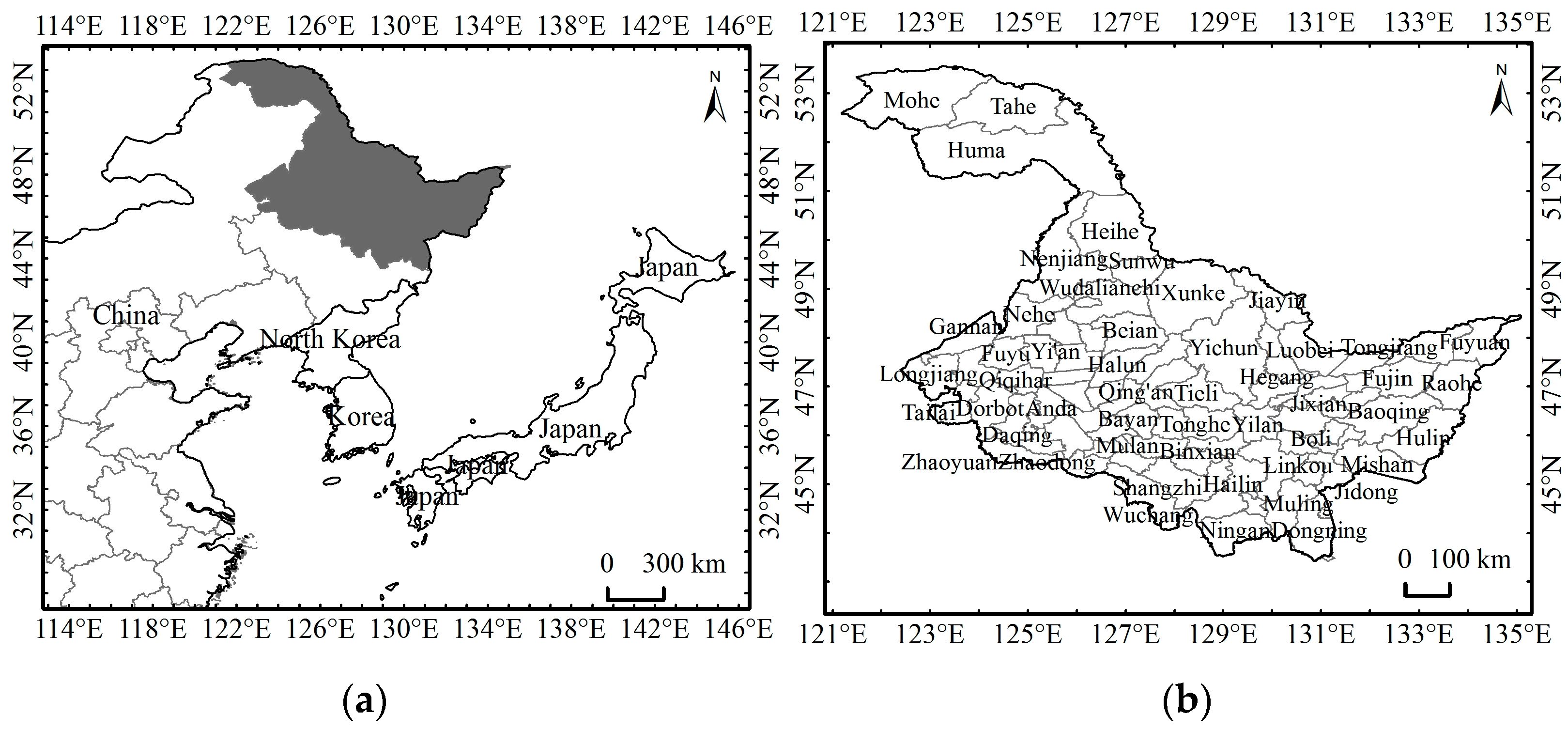
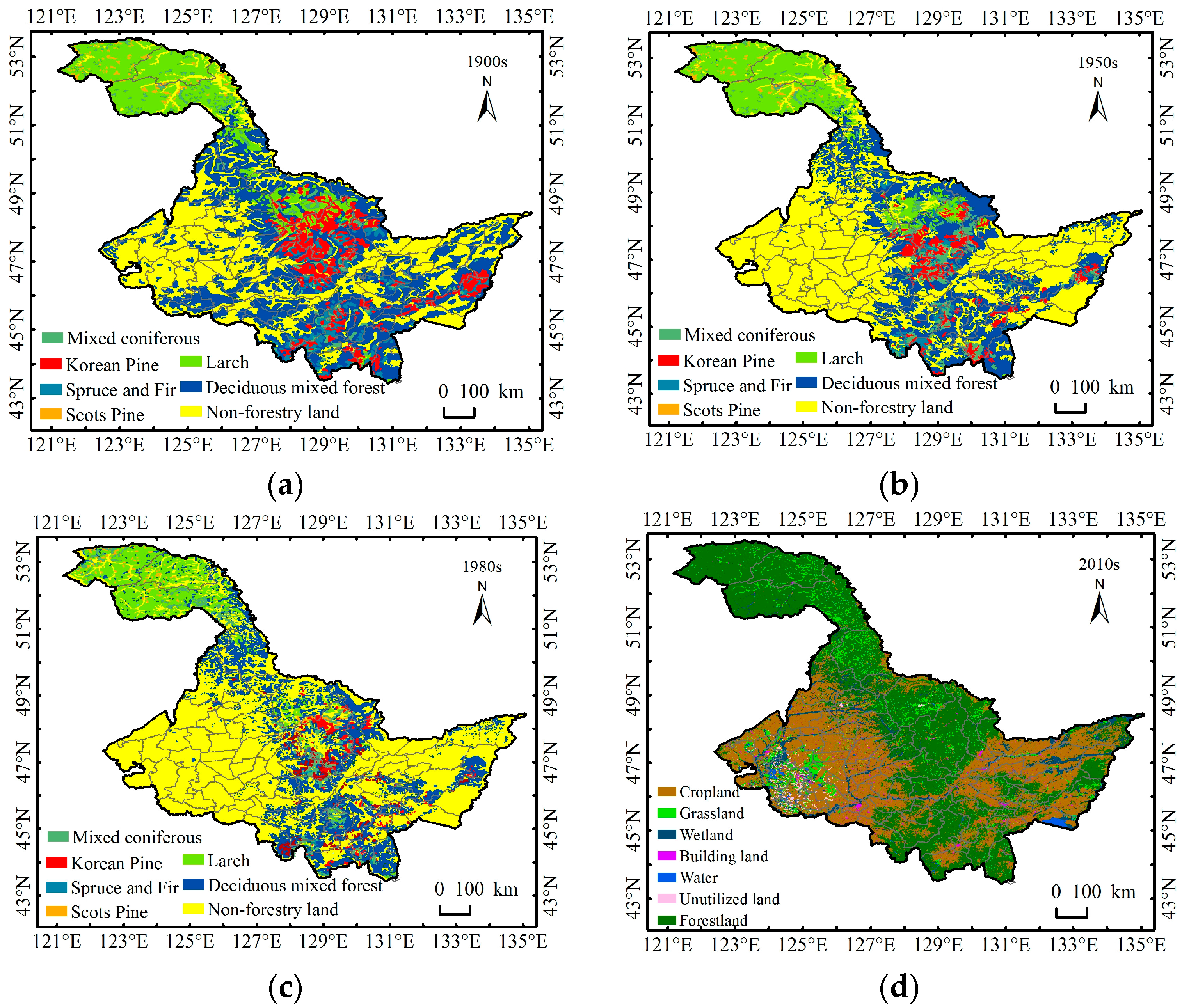
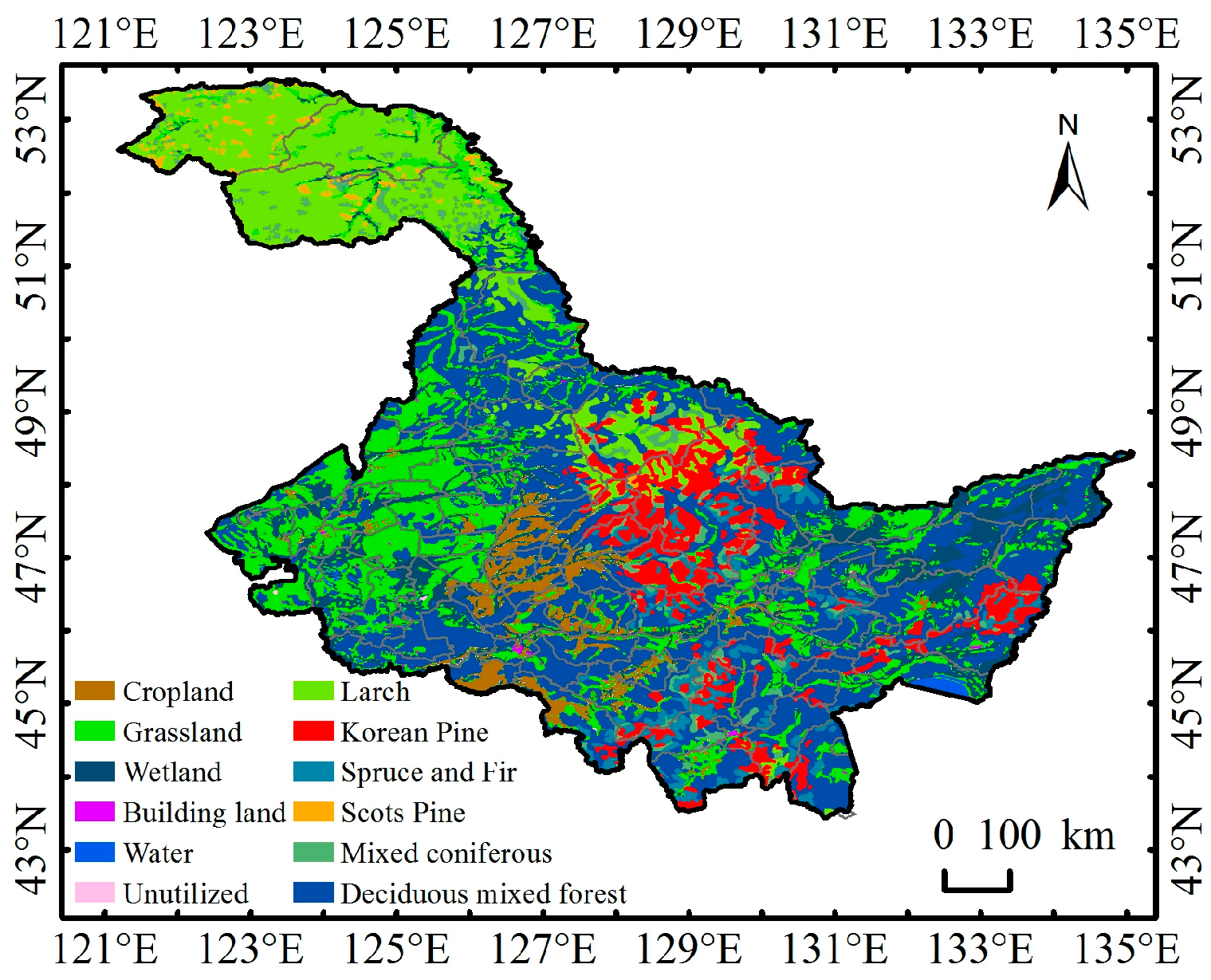
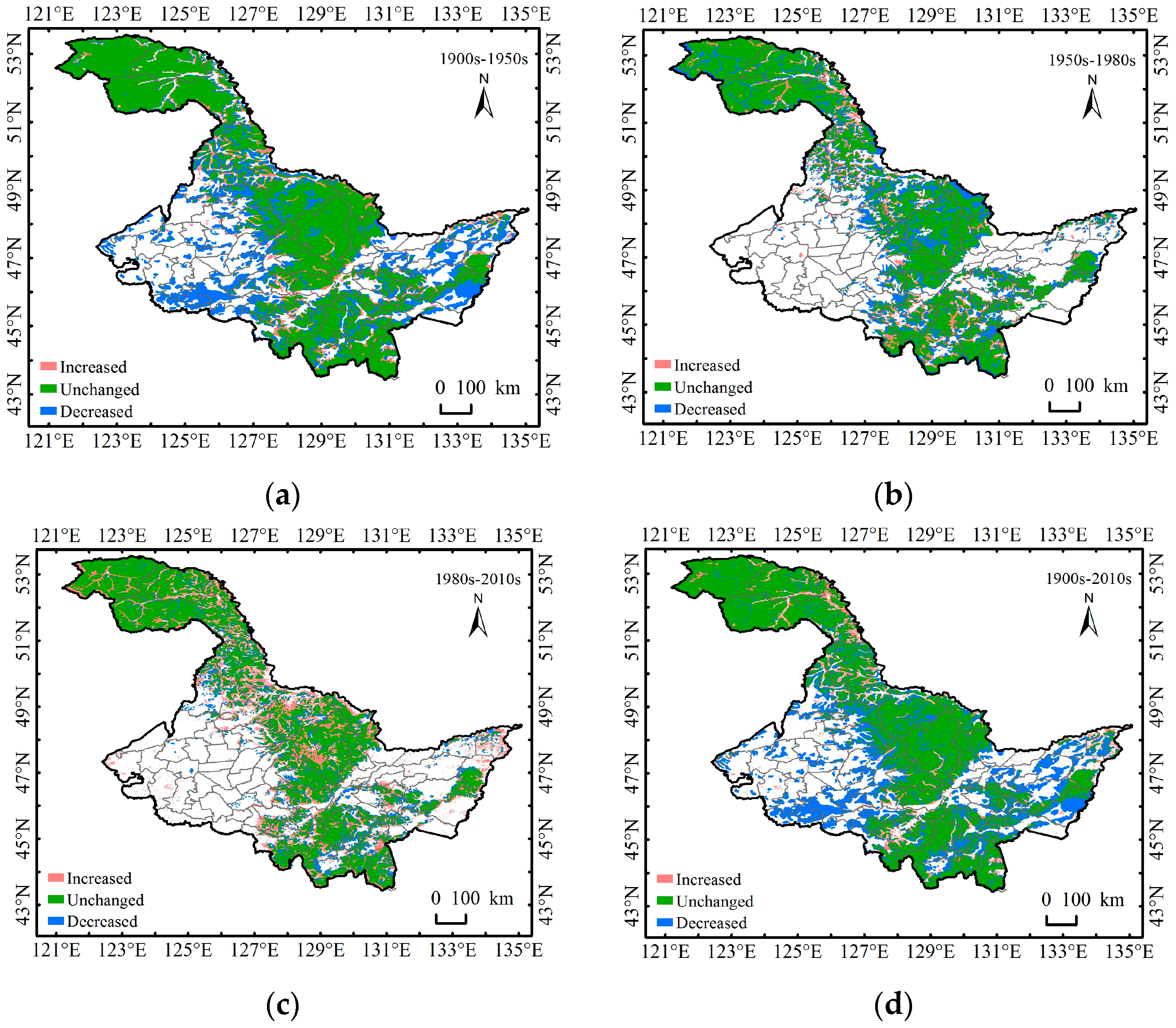

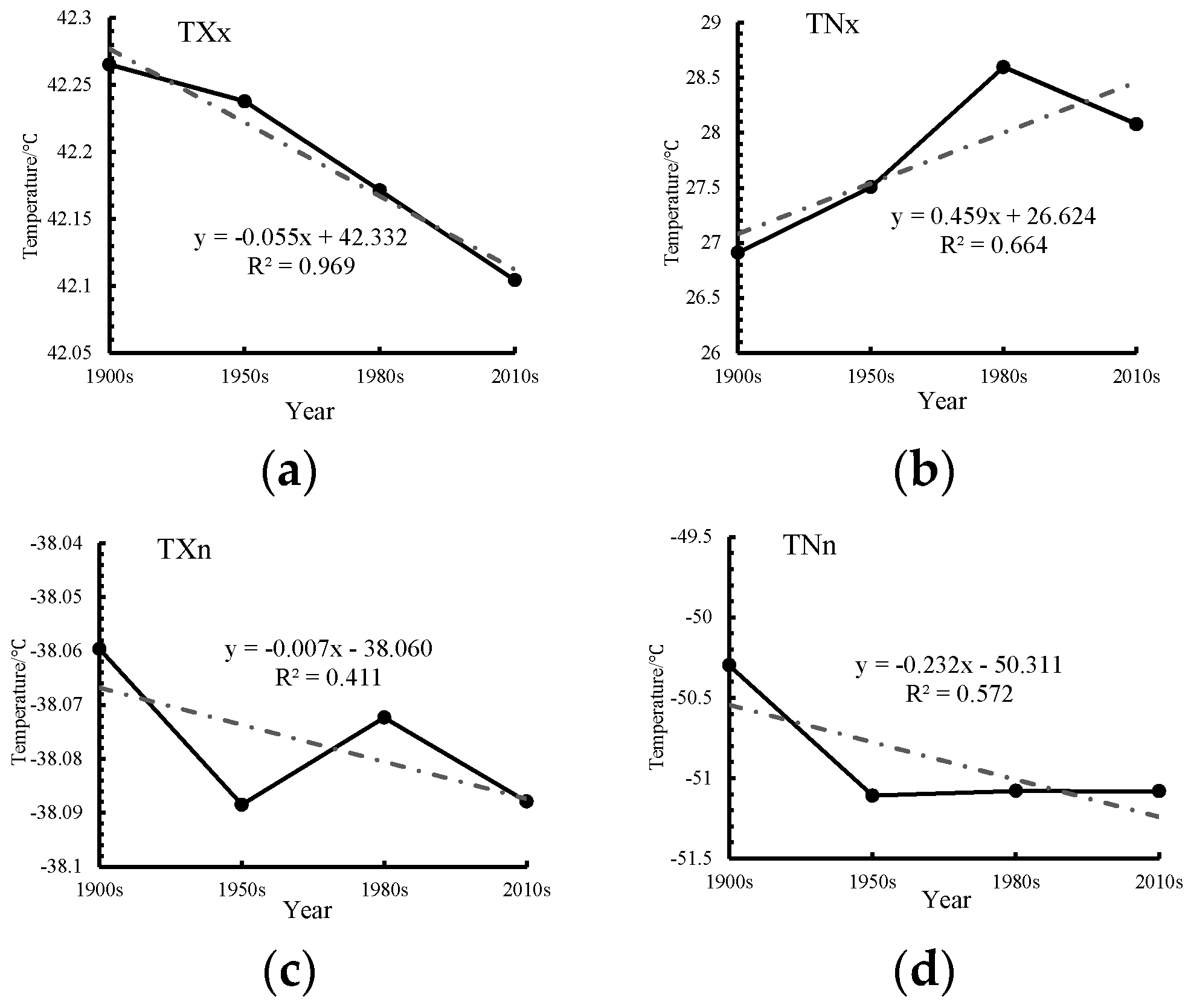
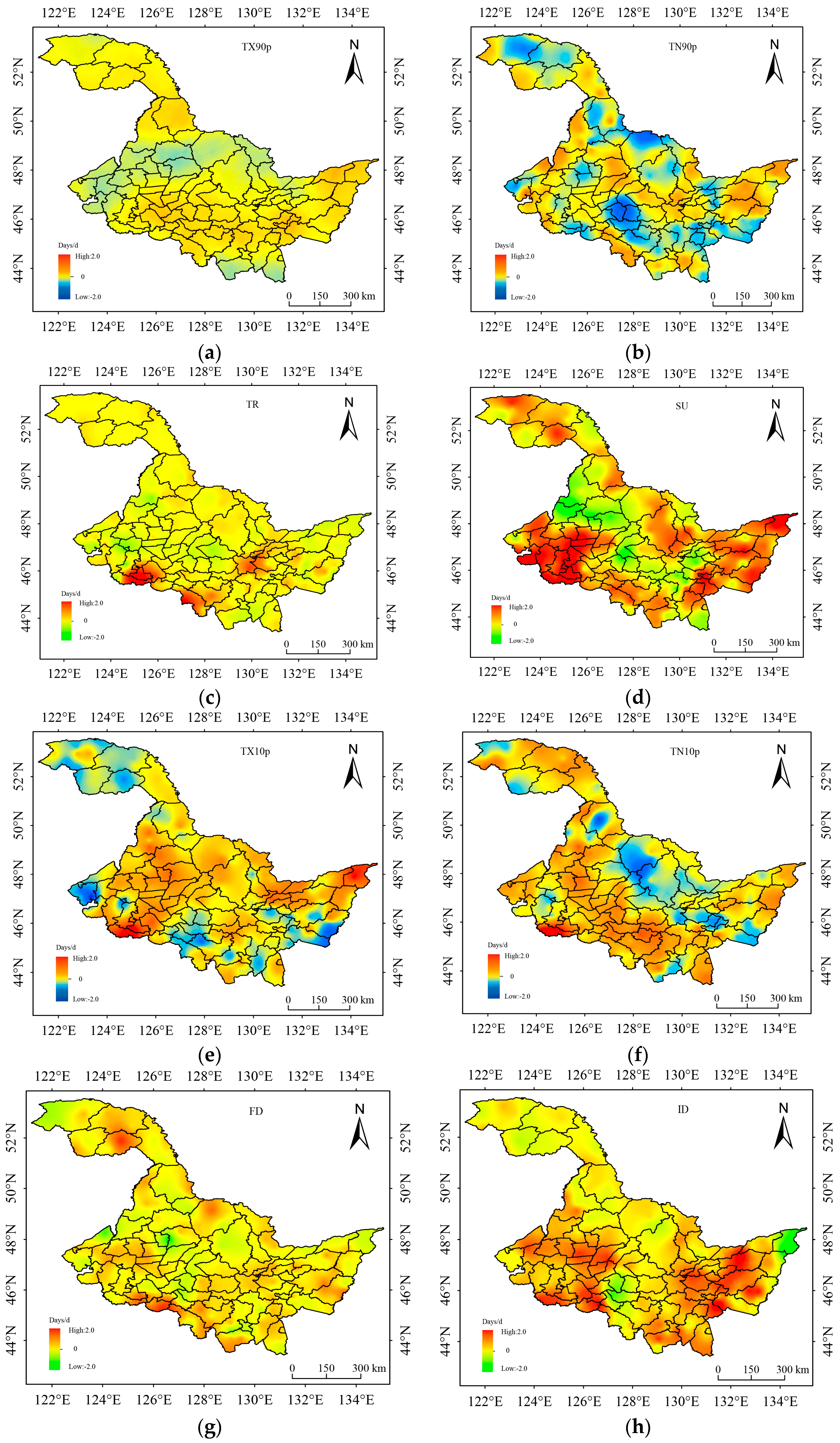
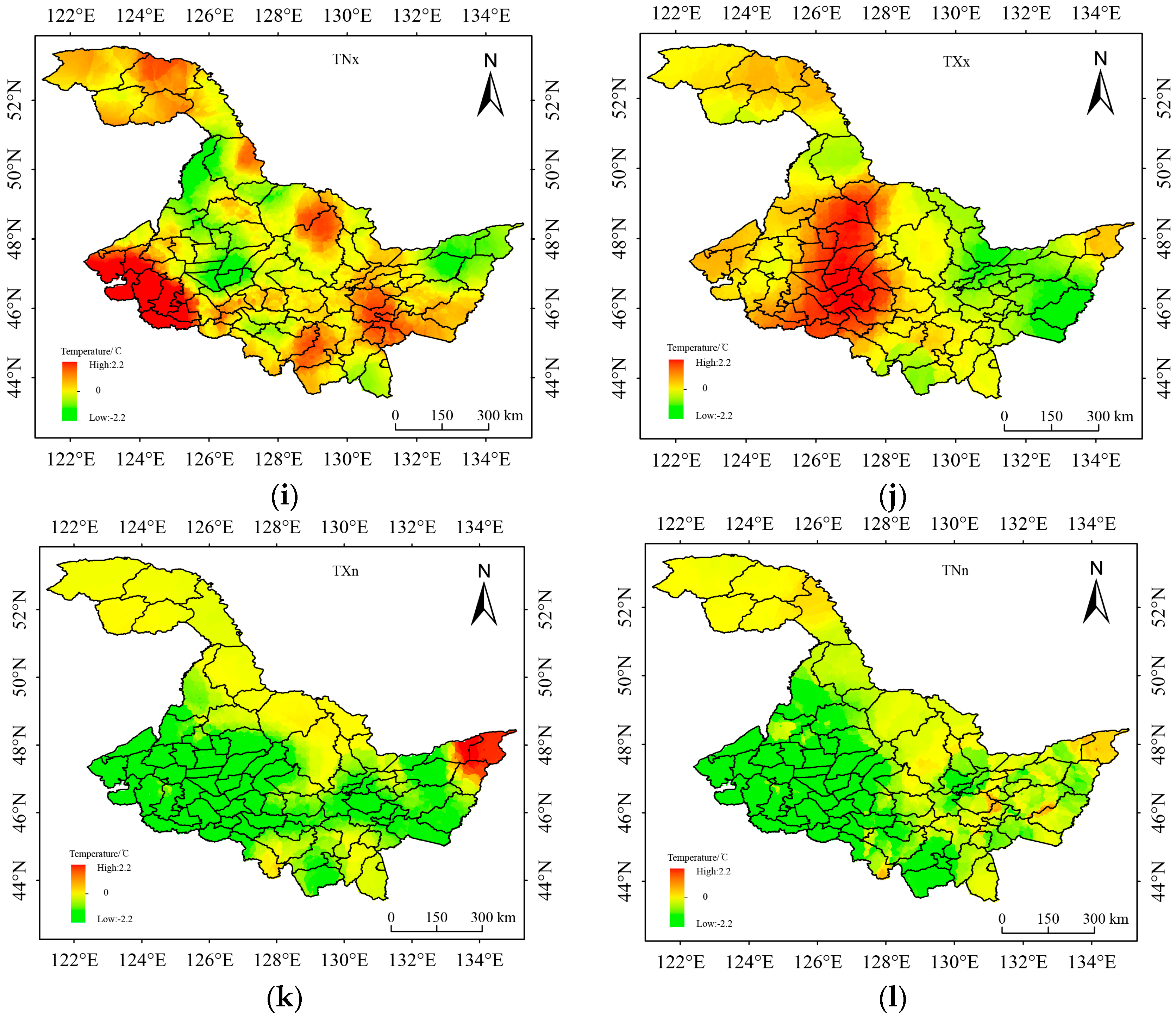
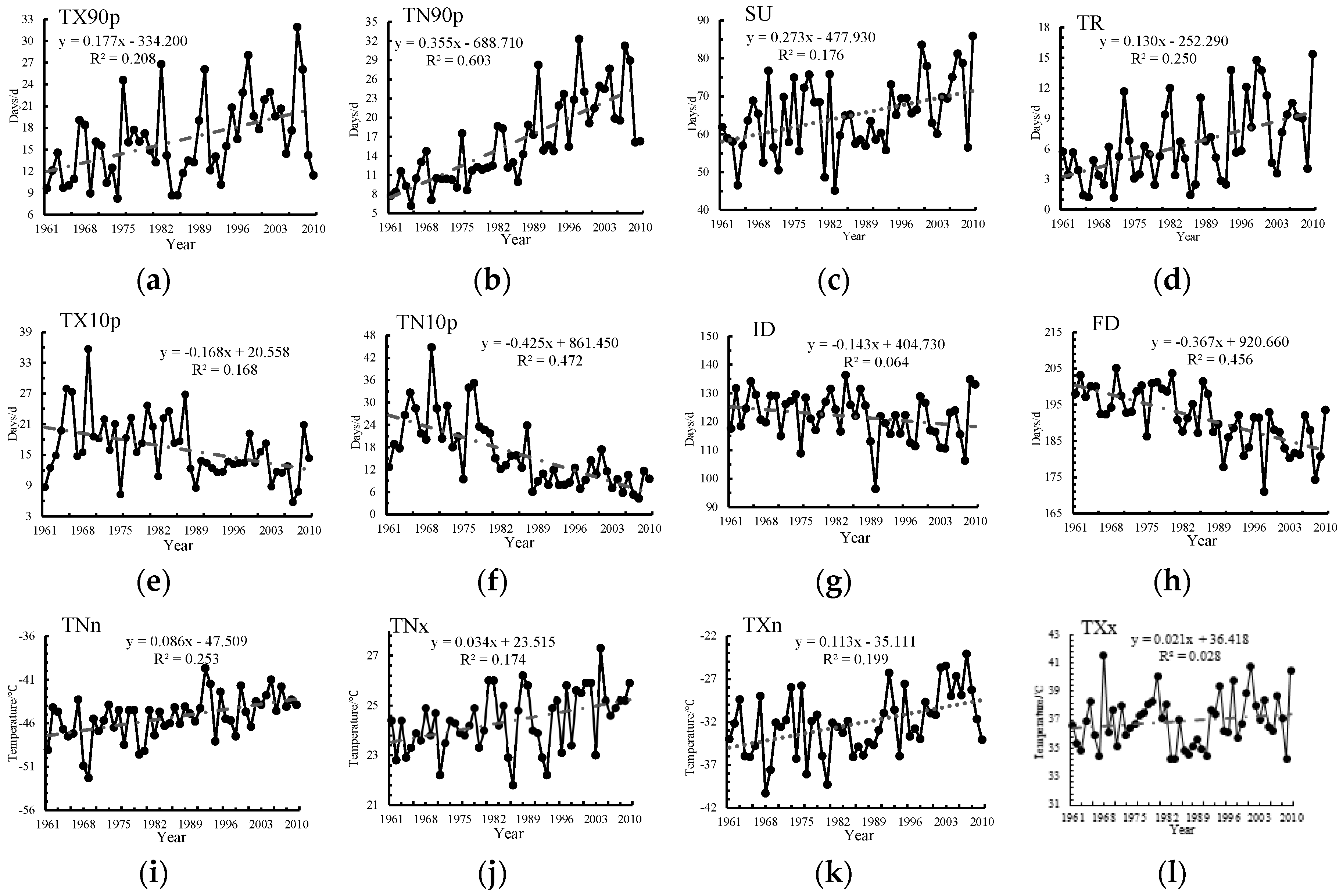


| Classification | Abbr. | Index | Definition | Unit |
|---|---|---|---|---|
| Relative index | TX90p | warm days | number of days where daily maximum temperature is greater than temperature at the 90% quantile between 1961 and 2010 in a year | d |
| TN90p | warm nights | number of days where daily minimum temperature is greater than temperature at the 90% quantile between 1961 and 2010 in a year | d | |
| TX10p | cold days | number of days where daily maximum temperature is less than the number of days at the 10% quantile between 1961 and 2010 in a year | d | |
| TN10p | cold nights | number of days where daily minimum temperature is less than the number of days at the 10% quantile between 1961 and 2010 in a year | d | |
| Absolute index | SU | summer days | number of days where the daily maximum temperature is greater than 25 °C in a year | d |
| TR | tropical nights | number of days where the daily minimum temperature is greater than 20 °C in a year | d | |
| ID | ice days | number of days with daily maximum temperature less than 0 °C in a year | d | |
| FD | frost days | Number of days with a daily minimum temperature less than 0 °C in a year | d | |
| Maximum and minimum value indexes | TXn | minimum value of daily maximum temperature | minimum value of daily maximum temperature in a year | °C |
| TNn | minimum value of daily minimum temperature | minimum value of daily minimum temperature in a year | °C | |
| TXx | maximum value of daily maximum temperature | maximum value of daily maximum temperature in a year | °C | |
| TNx | maximum value of daily minimum temperature | maximum value of daily minimum temperature in a year | °C |
| Index | R | Index | R |
|---|---|---|---|
| Number of warm days | −0.170 ** | Number of frost days | 0.008 |
| Number of warm nights | −0.110 ** | Number of ice days | −0.150 ** |
| Number of tropical nights | −0.220 ** | Maximum value of daily maximum temperature | −0.080 * |
| Number of summer days | −0.030 | Maximum value of daily minimum temperature | −0.120 ** |
| Number of cold days | −0.190 ** | Minimum value of daily maximum temperature | 0.360 ** |
| Number of cold nights | −0.130 ** | Minimum value of daily minimum temperature | 0.130 ** |
| Surface Albedo | Net Radiation Flux/W m−2 | Latent Heat Flux/W m−2 | Sensible Heat Flux/W m−2 | |
|---|---|---|---|---|
| Annual average | 0.007 | −0.906 | 0.246 | −0.918 |
| Spring | 0.013 | −2.859 | −0.104 | −1.923 |
| Summer | −0.001 | 1.112 | 1.287 | −0.428 |
| Autumn | 0.001 | −0.053 | −0.029 | −0.079 |
| Winter | 0.017 | −1.823 | −0.171 | −1.241 |
© 2017 by the authors. Licensee MDPI, Basel, Switzerland. This article is an open access article distributed under the terms and conditions of the Creative Commons Attribution (CC BY) license (http://creativecommons.org/licenses/by/4.0/).
Share and Cite
Zhang, L.; Pan, T.; Zhang, H.; Li, X.; Jiang, L. The Effects of Forest Area Changes on Extreme Temperature Indexes between the 1900s and 2010s in Heilongjiang Province, China. Remote Sens. 2017, 9, 1280. https://doi.org/10.3390/rs9121280
Zhang L, Pan T, Zhang H, Li X, Jiang L. The Effects of Forest Area Changes on Extreme Temperature Indexes between the 1900s and 2010s in Heilongjiang Province, China. Remote Sensing. 2017; 9(12):1280. https://doi.org/10.3390/rs9121280
Chicago/Turabian StyleZhang, Lijuan, Tao Pan, Hongwen Zhang, Xiaxiang Li, and Lanqi Jiang. 2017. "The Effects of Forest Area Changes on Extreme Temperature Indexes between the 1900s and 2010s in Heilongjiang Province, China" Remote Sensing 9, no. 12: 1280. https://doi.org/10.3390/rs9121280




